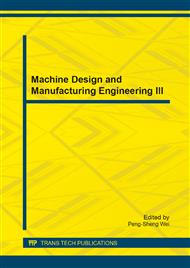[1]
National Health Medical Research Centre (NHRMC), 1992. National Indoor Air Quality for Total Volatile Organic Compounds. A Discussion Paper. 23.
Google Scholar
[2]
Hameed A.A., Farag S.A. An indoor bio-contaminants air quality. International Journal of Environmental Health Research 9, 1999. 313.
Google Scholar
[3]
S. N Kamaruzzaman an N. A Sabrani,. The Effects of Indoor Air Quality (IAQ) Towards Occupants' Psychological Performance in Office Buildings. Journal Design+Built, 2011. Volume 4; ISSN: 1985-6881.
Google Scholar
[4]
Dharmage S., Balley M., Raven J., Mitakakis T., Thien F., Forbes A., Guest D., Abramson M., Waiters E.H. Prevalence and residential determinants of fungi within homes in Melbourne, Australia. Clinical and Experimental Allergy 1999, 29, 1481.
DOI: 10.1046/j.1365-2222.1999.00640.x
Google Scholar
[5]
Plotrowska M., Zakowska Z., Giiscinska A., Bogusiawska-kozlowska J. The role of outdoor air on fungal aerosols formation in indoor environment. Proceedings of the II International Scientific Conference: Microbial Biodegradation and Biodeterioration of Technical Materials, 2001, 113-118, lódz, Poland, , [In Polish].
Google Scholar
[6]
La-Serna I., Dopazo A., Aira M.J. Airborne fungal spores in the Campus of Anchieta (la laguna, Tenerife/CanaryIs. ). Grana 2002, 41, 119.
DOI: 10.1080/001731302760156927
Google Scholar
[7]
Sarica S., Asan A., Otkun M.T., Ture M. Monitoring Indoor Airborne Fungi and Bacteria in the different Areas of Trakya university hospital, edirne, Turkey. Indoor and Built environ. 2002, 11, 285.
DOI: 10.1177/1420326x0201100505
Google Scholar
[8]
Peterman T.K., Jalongo M.R., Lin Q. The effects of Molds and Fungi on young Children's health: Families' and educators' Roles in Maintaining Indoor Air Quality. Early Childhood education Journal 2002, 30(1), 21.
Google Scholar
[9]
Yazicioglu M., Asan A., Ones U., Vatanseveru., Sen B., Ture M., Bostancioglu M., Pala O. Indoor air fungal spores and home characteristics in asthmatic Children from Edirne Region of Turkey. Journal of Allergy and Clinical Immunology, January, (2002).
DOI: 10.1016/s0091-6749(02)81258-1
Google Scholar
[10]
Rojas T.I., Martinez E., Gomez Y., Aivarado Y. Airborne spores of aspergillus species in cultural institution sathavana university. Grana 2002, 41, 190.
Google Scholar
[11]
Gutarowska B., Jakuaowska A. The estimation of moulds air pollution in university settings. In: Problems of indoor air quality in Poland'2001, T. Jedrzejewska-Scibak, J. Sowa, Publishing house of Warsaw, University of Technology Warsaw, 2002, 103-112, ed [In Polish].
Google Scholar
[12]
Daisey J.M., Angell W.J., Apte M.G. Indoor air quality, ventilation and health symptoms in schools: an analysis of existing information. Indoor Air 2003, 13, 53.
DOI: 10.1034/j.1600-0668.2003.00153.x
Google Scholar
[13]
Karwowska E. Microbiological Air Contamination in Some educational Settings. Polish J. Environ. Studies 2003, 12(2), 181.
Google Scholar
[14]
Wojcik-stopczynska B., Flakowski J., Jakubowska B. Mikroflora of university canteen air. Pzh Annals 2003, 54 (3), 321, [In Polish].
Google Scholar
[15]
Filipiak M., Piotraszewska-pajak A., Stryjakowska-Sekulska M., Stach A., Silny W. Outdoor and indoor air microflora of academic buildings in Poznan. Progress in dermatology and Allergology 2004, 21(3), 121.
Google Scholar
[16]
Wong, L. T., Mui, K. W., Hui, P. S., & Chan, W-y. 2009. Assessment parameters for indoor air quality IAQ in air-conditioned offices, Facilities, 275/6, 202- 210.
DOI: 10.1108/02632770910944934
Google Scholar
[17]
Department of Safety and Health (DOSH) Malaysia. Industrial Code of Practice on Indoor Air Quality. (2010).
Google Scholar
[18]
Polish Standard PN 89/Z-04008/08.
Google Scholar
[19]
Parat S, Perdrix A, Fricker H H, Saude I, Grillot R, Baconnier P. Multivariate analysis comparing microbial air content of an air-conditioned building and a naturally ventilated building over one year. Atmospheric Environment, 1997, 31: 441-449.
DOI: 10.1016/s1352-2310(96)00212-9
Google Scholar
[20]
Pastuszka J S, Pwa U K T, Lis D O, Wlazlo A, Ulfig K. Bacterial and fungal aerosol in indoor environment in Upper Silesia, Poland. Atmospheric Environment, 2000, 34: 3833-3842.
DOI: 10.1016/s1352-2310(99)00527-0
Google Scholar


